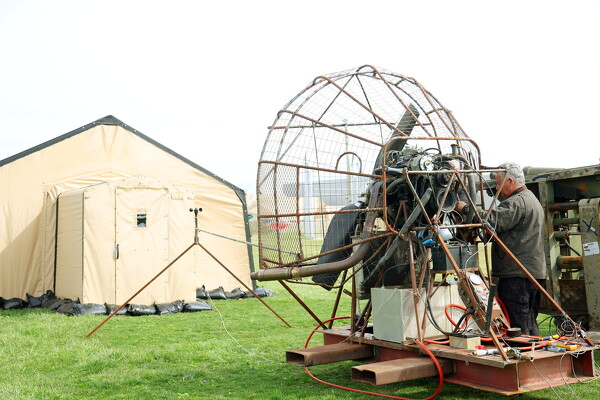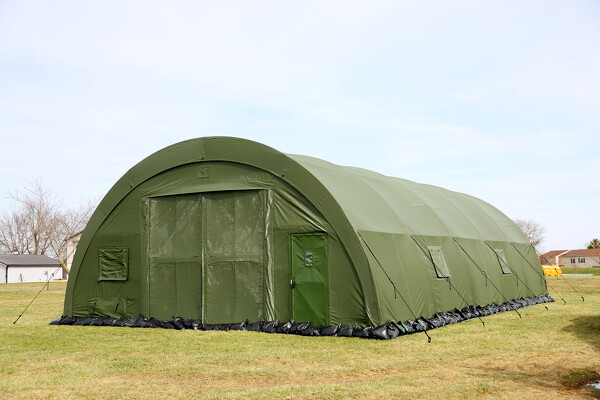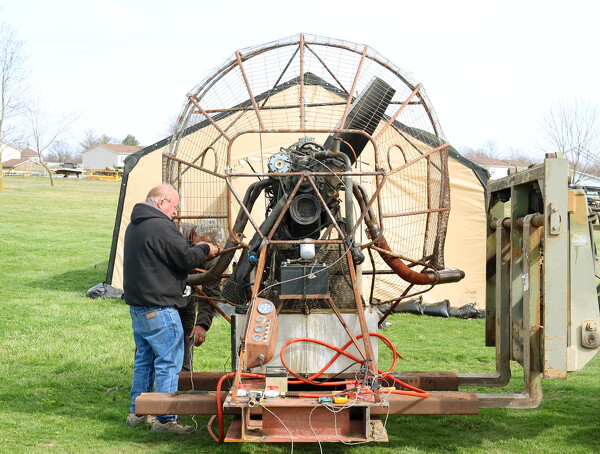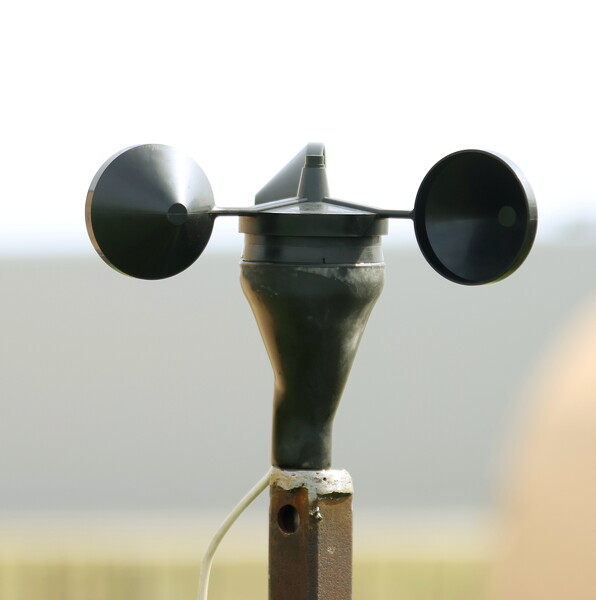
Environmental Testing Laboratory of Dallas, Texas use a V8 engine-powered airboat propeller to test one of Celina Tent's fully set up small shelter on Tuesday at their facility.
CELINA - A Texas company on Tuesday began simulating the type of wind and gust speeds seen during a hurricane to determine just how much of a beating Celina Tent's products can withstand.
So far, so good, as Celina Tent's fully-erected and properly-staked 20-by-32 foot dynamic small shelter - one of three tent models to be tested over three days - endured the sustained pummeling of 90 mph winds and 100 mph gusts produced by a V8 engine-powered airboat propeller.
Celina Tent vice president Janice Grieshop and engineering manager Jill Howe were thrilled with the outcome.
"I wasn't back here since lunch, and I thought as we came around the corner, 'I sure hope they're standing,'" Grieshop said.
"Very pleased," added Howe. "It was my first experience seeing this type of environmental testing. It was very exciting to see the shelter was standing. We weren't sure what we would see."

One of Celina Tent's fully-erected small shelters.
Grieshop already knows the tents used as humanitarian and military tactical shelters around the globe can survive harsh conditions but wanted to officially test and document their capabilities to use as another marketing tool.
That's when Celina Tent called in Environmental Testing Laboratory (ETL) of Dallas, Texas, to put its tents to the test. The testing firm traveled to Celina and brought along two engine-powered airboat propellers, one standalone unit and another still attached to an airboat.
The testing firm is conducting a series of wind and gust tests on three different kinds of tents through Thursday on Celina Tent's sprawling campus along State Route 29.
"There's some pretty windy places in the world. South America is pretty breezy down there," said ETL owner Brady Richard, whose company also provides environmental product testing for military and aerospace.

Tom Truitt, an owner of one of the airboats, does a few maintenance checks on the propellor before beginning testing.
Another test involves spraying water from a nozzle system fastened on the front of the boat propeller to simulate a downpour.
"It's very important for showing our customers what these things can sustain. They go in many different environments," Howe said of the company's tents. "We do a lot of hand calculations to try to build the design, but the physical test is where it really shows what it's capable of."
The tents have withstood tornadoes, but could they weather the incessant blows of hurricane-force winds?
"One of the things that's interesting to me seeing this today for the first time is when the wind is applied, the fabric oscillates and moves quite a bit, which is pulling and tugging on that metal," Howe said.
Each test lasts 30 minutes, according to Howe.
"We do it at three configurations," she said. "We do it facing the end at a 45-degree angle and then also to the length of the shelter. When we do the length of the shelter, we actually apply two fans to it."

An anemometer measures the wind speed during testing of the tents.
The dynamic small shelter tent aced both the wind and water intrusion tests, to the delight of Howe and Grieshop.
Tests of the dynamic medium shelter and Adaptive Color and Environment (ACE) shelter will continue today and Thursday.
Celina Tent manufactures and distributes tents, tarpaulin, ducting and military vehicle accessories worldwide. Its products are used in government, rental and hospitality industries.
It has provided products for numerous federal agencies, including the Department of Defense and Department of Homeland Security, as well as hospitals, universities and rental companies.
"I always love saying, 'We do everything from sugar beet bags to military shelters,'" Howe said.
Almost all of the work from design and engineering to metal fabrication and manufacturing takes place at Celina Tent's campus of multiple facilities, together amounting to 285,000 square feet. Today it has about 83 employees, Grieshop said.
"If they're small tents, we can just knock them out all day, and a larger tent, it takes longer, but we're doing all different parts of the tent every day," Grieshop noted.
Around Christmastime, Celina Tent relocated some of its staff from the St. Marys Square Business Complex to its latest 100,000-square-foot fabric manufacturing addition at the Celina campus. Grieshop said the move and expansion have resulted in greater efficiency.